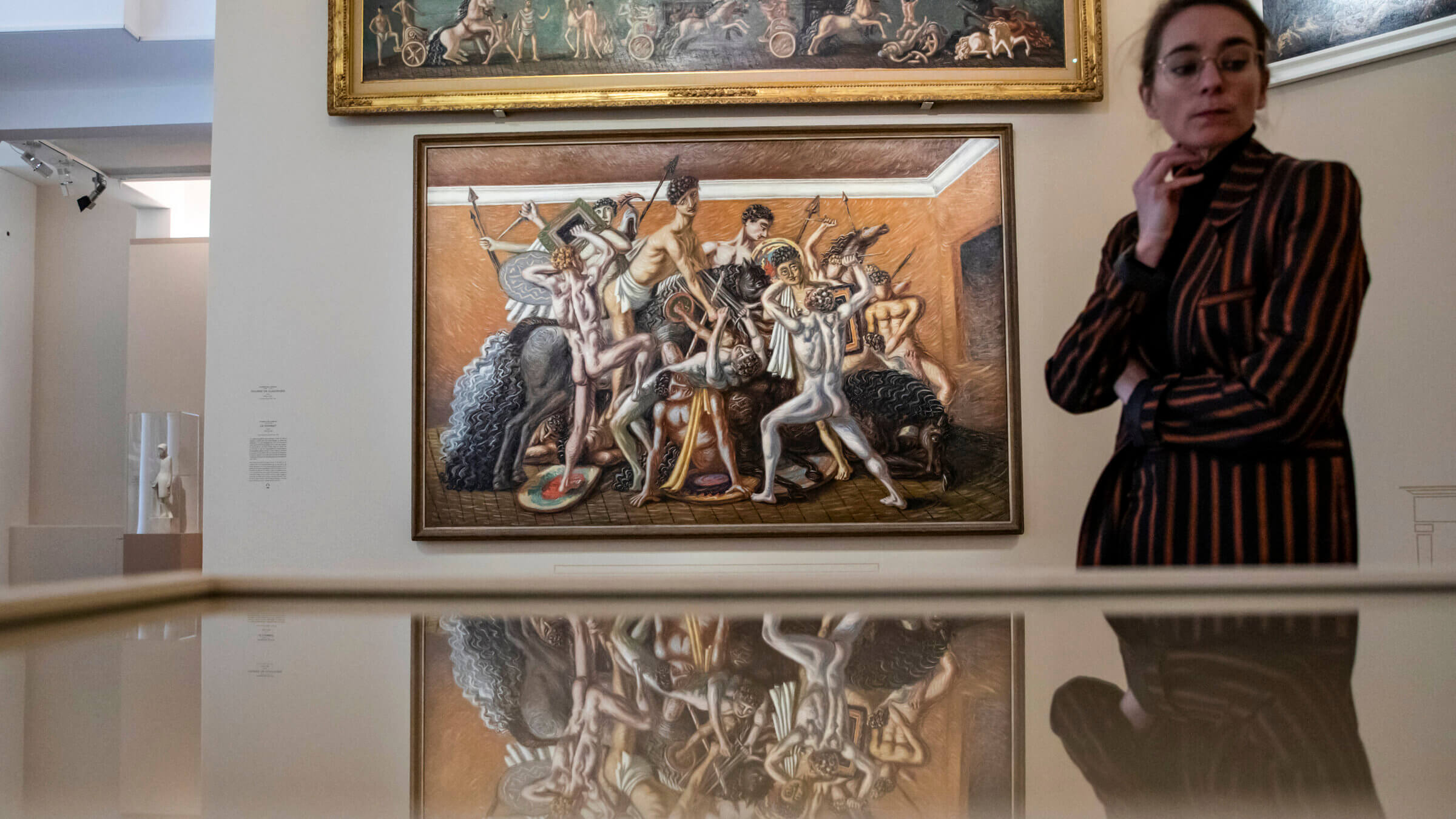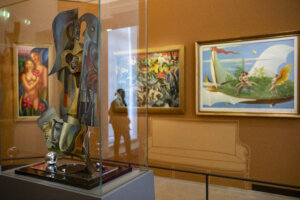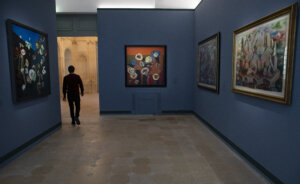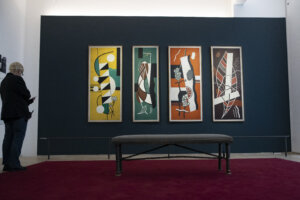In a Jewish art dealer’s Paris apartment, a jaw-dropping collection of 20th-century masterworks
The Picasso Museum attempts to re-create the home of Léonce Rosenberg, dealer for Picasso, Léger, Ernst and scads more

An exhibition staff member stands near artworks Chariot Race (top) and The School of Gladiators: The Combat by Italian painter Giorgio de Chirico at the press preview of the Dans l’appartement de Léonce Rosenberg – De Chirico, Ernst, Léger, Picabia exhibition at the Picasso Museum in Paris. Photo by Getty Images
It was “a crazy project,” the art historian and curator Giovanni Casini told me. A really crazy project. And it is the subject of a major exhibition now on view at the Picasso Museum in Paris.
The exhibition highlights the Jewish art dealer Léonce Rosenberg, one of the major French art dealers of the first part of the 20th century, a devotee of Cubist and other abstract avant-garde art.
But it’s not about Rosenberg’s gallery, or the art he sold in it. It specifically showcases his apartment — his late 1920s apartment on the rue de Longchamp in Paris’s elegant 16th arrondissement. An apartment filled with art Rosenberg commissioned that was designed for the 11 rooms in his more-than-3,800-square-foot home by pioneering artists such as Giorgio de Chirico, Fernand Léger, Francis Picabia and Max Ernst.
Rosenberg “played a key role, especially in the years of the First World War,” Casini told me over FaceTime. Casini is the author of Léonce Rosenberg’s Cubism: The Galerie L’Effort Moderne in Interwar Paris. He co-curated the exhibit with Juliette Pozzo, who is in charge of Picasso’s personal collection at the Picasso Museum.
“He decided to promote avant-garde art and take on the destiny of Cubism and really make a movement out of what was a heterogeneous group of artists that were working with a similar style. And he tried to get them all together and promote them through the activities of his gallery (L’Effort Moderne),” Casini said.

Rosenberg was a dealer for Pablo Picasso mostly from 1914-15 to 1919, (Rosenberg’s more famous younger brother, Paul, was also an art dealer and represented, among others, Picasso, Georges Braque and Henri Matisse.)
“During the 1920s Léonce continued to operate his gallery, organize exhibitions and promote the work of certain artists,” said Casini, who also did his doctoral thesis on Rosenberg and the dealer’s gallery. “Then in 1928 he conceived this project. He rented a very large apartment in the 16th arrondissement.”
It was, according to Casini, “a way to realize the dream he had nurtured throughout his career — to live surrounded by modern art. That for him meant Cubism, but also other art — the most advanced art of his time.”
The principle Rosenberg followed, Casini said, “was to assign each room to one artist and to commission, to ask each artist to produce works — kind of decorative ensembles specifically for that site, often truly in dialogue with the furniture he selected for each space, which was mostly from the 19th century, with the exception of a large Art Deco dining room. It’s not that he displayed his personal collection, his preexisting collection. He commissioned site-specific decorative ensembles” from his painters and sculptors.
“Francis Picabia created a decorative cycle for the bedroom of Madame Rosenberg,” Casini said. “They had three daughters, and their rooms were also decorated by artists. For one of them he commissioned Max Ernst, the well-known surrealist artist, to create a cycle, an ensemble.”
More rooms featured the works of lesser-known artists, among them Jean Metzinger, Gino Severini, Alberto Savinio, Auguste Herbin, Yervand Kochar and Manuel Rendón Seminario.

“The apartment and the decoration of the apartment offer a snapshot of what was modernism in Paris at the end of the Roaring ’20s,” Casini said. “And it’s kind of an unfamiliar snapshot. There are some artists that are quite well-known, but there are a bunch of others who are more or less completely underestimated or unknown.” He said he is hopeful that the exhibition “will provide the opportunity to rediscover the work of artists that have been unjustly marginalized.”
The exhibition contains some 40 of the more-than-90 artworks that were in the apartment, many of which, he said, came to the museum from private collections in the United States and Europe. It also includes photographs and plans of the apartment, archival documents and letters. Because it was not possible to locate the original furniture, Casini noted in an email, the museum “opted for an evocation of the furniture through some silhouettes applied to the walls, inspired by the photos of the apartment.”
In addition, he noted, the exhibition has “an introductory section, with 10 works by Picasso, paintings and works on paper, to evoke the relationship between the artist and the dealer.” One of the works is a pencil portrait of Rosenberg with Picasso’s “Harlequin” from 1915, a painting now at the Museum of Modern Art in New York.

As it turned out, Rosenberg’s “crazy project” was not long-lived. “The effect of the Wall Street crash of 1929 reached Europe in 1930-31,” said Casini. “It’s when Rosenberg starts seeing that it’s not going to work, that the apartment is not sustainable any more. By 1932 he has to leave.”
He sold the furniture at auction in Paris, Casini said, but “the painted ensembles that he had commissioned, it seems that he kept them, and he sold the works very slowly over the years.”
Following the onset of WWII, Rosenberg’s brother Paul and family fled to the United States, but Léonce remained, even as he had to abandon his gallery. “He was forced to wear the yellow star,” Casini said. “What we understand is that he became really discreet as a strategy of survival.”
“He was already not such a prominent dealer,” Casini continued, “and his gallery was no longer one of the major galleries in Paris, so that made him less of a target for the Nazis.”
Rosenberg died in 1947, aged 67. “He had to endure hardship because of the conditions he was forced to live in” during the occupation, Casini said. “The fact that he died quite soon after the war was also due to that.”
By then the apartment was long gone, a memory of a distant and different time. A memory now recreated in a museum situated in Paris’ Marais district — appropriately, its historic Jewish quarter.
The exhibit Dans l’appartement de Léonce Rosenberg runs through May 19 at the Picasso Museum in Paris.















